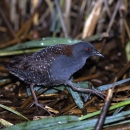Featured Species
The brackish marshes of Cedar Island National Wildlife Refuge and the adjacent open water bodies of Pamlico Sound provide important habitat for waterfowl, wading birds, secretive marsh birds, and colonial waterbirds. The refuge marshes are some of the most important locations for breeding black rails, a species of special management concern in the southeast. They also provide important habitat for seaside sparrows, American black ducks, Virginia rails, and clapper rails. Isolated islands and sand spits are used as breeding sites for American oystercatchers, gull-billed terns, least terns, and other colonial species. Gray squirrels and marsh rabbits are abundant. White-tailed deer are present, though not in high density. Furbearers that have been observed include raccoon, mink, muskrat, otter, fox, nutria, and opossum. A total of 35 mammal species are believed to be present on the refuge; however, no formal inventory has been conducted.A total of 92 amphibian and reptile species, including 42 amphibian and 51 reptile species, are believed to be present on the refuge; however, no formal inventory has been conducted. Species observed include southern leopard frog, green tree frog, black rat snake, eastern cottonmouth, yellow-bellied turtle, and snapping turtle.


